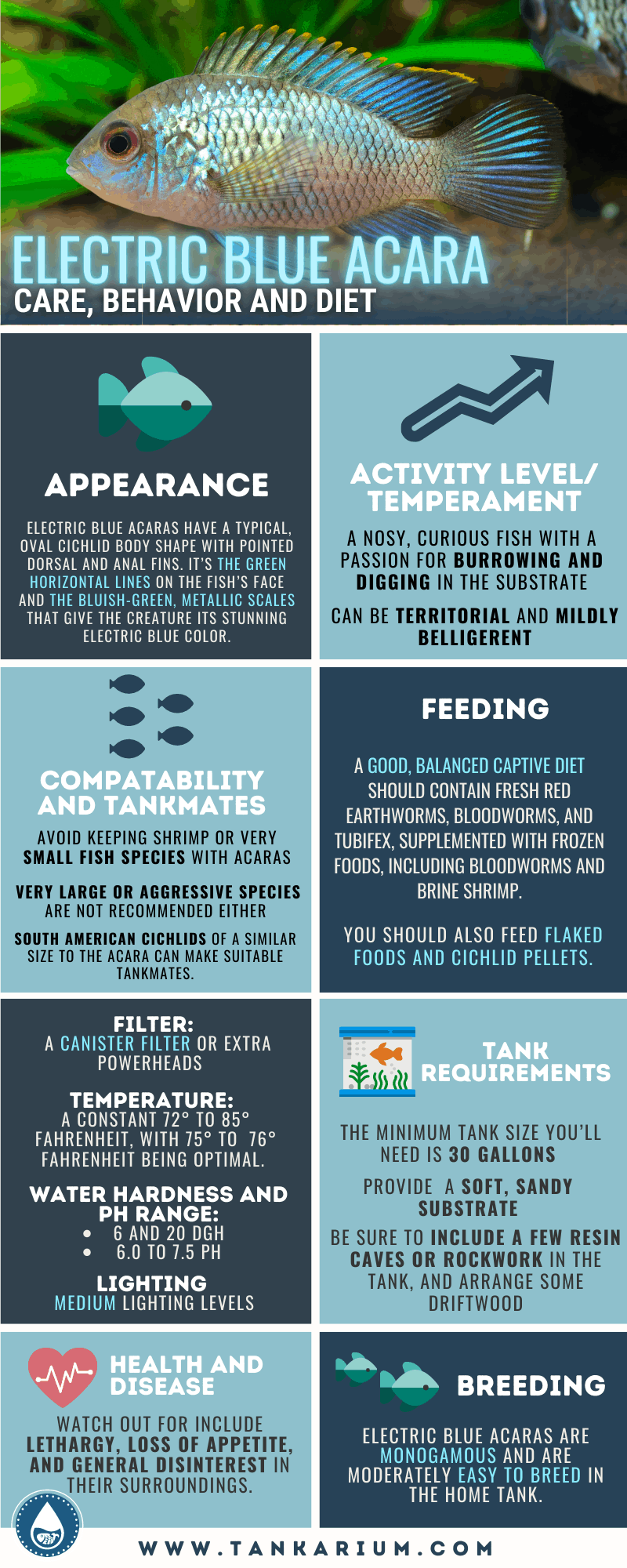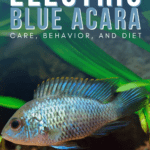For many years, the Electric Blue Acara has been an extremely popular choice for those with a South American cichlid aquarium. Not only is the fish blessed with absolutely beautiful looks, but the Blue Acara is also one of the more peaceful of the cichlids, making it a good choice for a community tank of similar-sized, amenable species.
These fish are extremely hardy and easy to care for, making them a good choice for a novice hobbyist. Electric Blue Acaras readily form pairs and will regularly breed in a home tank setting, diligently caring for their fry without becoming overly aggressive toward other aquarium residents.
Fish Profile
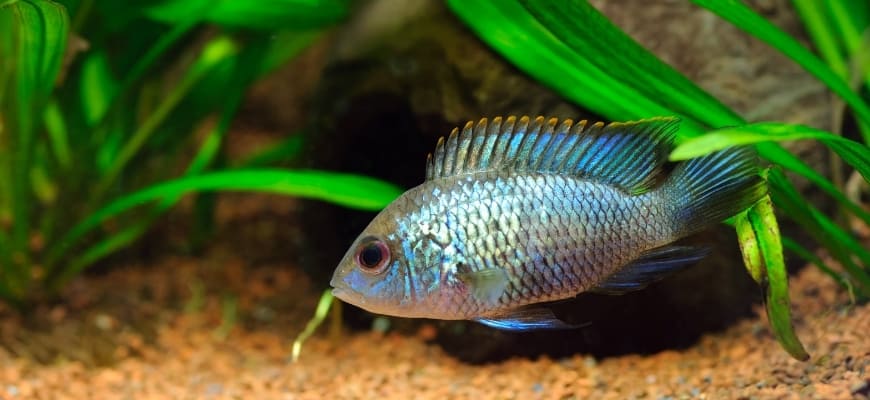
Scientific Name
Aequidens pulcher
Common Name (species)
Electric Blue Acara, Blue Acara
Family
Cichlidae
Origin
Central and South America, Colombia, Venezuela, and Trinidad
Diet
Omnivore: Flakes, cichlid pellets, shrimps, fishes, worms
Care Level
Easy
Activity
Semi-peaceful, likes to burrow and dig
Temperament
Can be territorial when spawning
Tank Level
All areas
Minimum Tank Size
30 gallons
Temperature Range
Tropical 72° to 85° F
Water Hardness
dGH 3 – 20
pH Range
6.5 to 8.0
Filtration/Flow Rate
Prefers well-filtered water with a strong flow rate
Breeding
Egg layer
Compatibility
Peaceful when kept with other large cichlids and similar species
OK, for Planted Tanks?
Uproots plants, especially when spawning
Origins
These gorgeous, large cichlids are found in the South and Central areas of South America, Columbia, Trinidad, and Venezuela.
The fishes’ preferred habitat is streams where the current is strong, and the water is clear and well-oxygenated. However, Blue Acaras are also sometimes found in standing water, where they feed on insects, crustaceans, worms, and some plant matter.
Appearance
Electric Blue Acaras have a typical, oval cichlid body shape with pointed dorsal and anal fins. In male specimens, the fins are longer than the female’s, and the rays of the anal and dorsal fins typically arch around the caudal fin. These are stocky, compact fish, growing to reach up to seven inches in length when fully mature, although they are capable of breeding at around four inches long.
What sets the Blue Acara apart is its remarkably vibrant coloration. The fish’s body is mainly steel-gray with stripes and spots on its head and body. But it’s the green horizontal lines on the fish’s face and the bluish-green, metallic scales that give the creature its stunning electric blue color.
Size
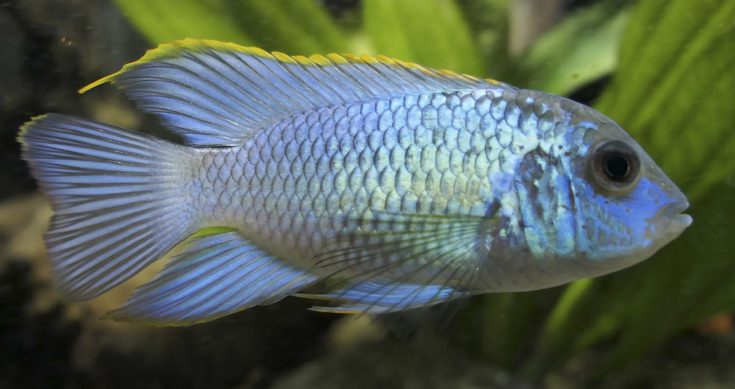
The Electric Blue Acara typically grows to a max size of between six and seven inches in length.
Activity Level/Temperament
The Electric Blue Acara is a nosy, curious fish with a passion for burrowing and digging in the substrate. That behavior in the fishes’ wild environment enables them to find food, but in the home aquarium, the Acara’s habit of persistently disturbing the substrate can be a nuisance, especially if you have live plants in the setup.
Although these are one of the more peaceful cichlids, the Electric Blue Acara can be territorial and mildly belligerent, especially when spawning, so I recommend that you keep your specimens with other large cichlids.
Compatibility And Tankmates
Electric Blue Acaras are pretty peaceful creatures that make a nice addition to a community setup. That said, it’s best to avoid keeping shrimp or very small fish species with Acaras, as these little guys will most likely become lunch. On the flip side, I don’t recommend very large or aggressive species either, as they may harass and stress the Acaras.
South American cichlids of a similar size to the Acara can make suitable tankmates. You might also want to include some peaceful bottom dwellers, such as plecos or Corydoras catfish. Other suitable community members include Discus, Pearl Cichlids, Uaru Cichlids, and Angelfish.
Feeding
With any fish species, it’s vital that you replicate the animal’s natural diet as closely as you can. That will help to keep the fish healthy and bring out its most vibrant colors. I also recommend that you buy the best quality food that you can find for your fish. There’s no point in trying to save a few dollars by purchasing cheap, poor quality food, as that won’t be good for your fishes’ health in the long-term.
What To Feed The Blue Acara
Electric Blue Acaras are omnivorous, although most of their wild diet is made up of meaty protein. In their natural environment, the fish are predatory, eating crustaceans, insects, and worms. A good, balanced captive diet should contain fresh red earthworms, bloodworms, and tubifex, supplemented with frozen foods, including bloodworms and brine shrimp. You should also feed flaked foods and cichlid pellets.
How Much And How Often To Feed
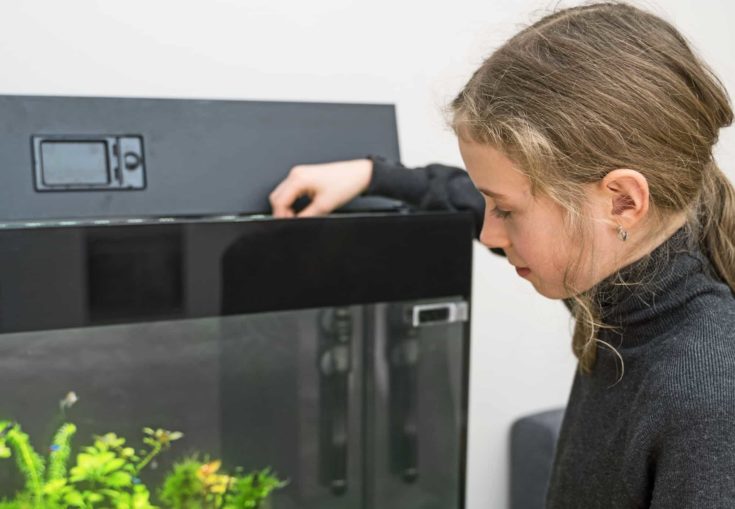
Be careful not to overfeed your Blue Acaras, as that can lead to digestive disorders. The best strategy is to feed your fish two or three times each day, offering small amounts that the fish will devour in just a couple of minutes.
Tank Requirements
As with all species of fish, providing your pets with an environment that closely mirrors that of their preferred wild habitat can go a long way to keeping the fish content and stress-free. Stress is extremely harmful to aquarium fish and is known to weaken the animals’ immune system. Once that happens, the fish are more likely to fall victim to attack by the parasites that cause common fish diseases, such as Ich and Fin Rot.
Tank size
These are quite large fish, and they do need plenty of swimming space, so the minimum tank size you’ll need is 30 gallons. When stocking your aquarium, be sure to allow one gallon of water per one inch of fish.
The best tank shape to choose for the Blue Acara is long rather than tall. That provides the fish with enough room to swim. A long tank also has more surface area than a tall one, which makes for the greater oxygenation that this fish species prefers.
Tank Setup
Substrate
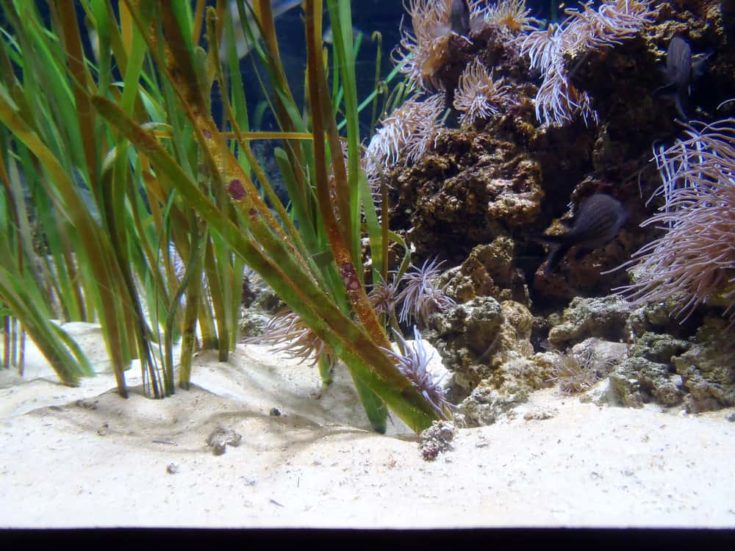
The Electric Blue Acara does like to burrow, and for that reason, it’s important that you provide your fish with a soft, sandy substrate, rather than hard gravel that could injure the fish. If you can find a dark-colored substrate, that will help to really show off the fishes’ stunning, metallic coloration to the best effect.
Dried Leaves
In the Blue Acara’s natural habitat, the substrate is often covered with leaf litter. You can replicate that in the home aquarium by adding a layer of dried leaves to the tank. The leaves give the setup a natural vibe, as well as offering a platform for colonies of naturally occurring microbes to grow on.
Decorations
Blue Acara enjoy caves and areas of dense planting where they can hide if they feel stressed. So, be sure to include a few resin caves or rockwork in the tank, and arrange some driftwood to create extra hiding places for the fish.
This species does appreciate the inclusion of live plants in the tank and uses vegetation for cover and shade. However, as a digger, Acaras do tend to uproot plants, so I suggest using potted plants that are not easily dislodged. Floating plants are also a good choice, as they help to diffuse the lighting and provide shelter for fry.
Setting Up The Aquarium
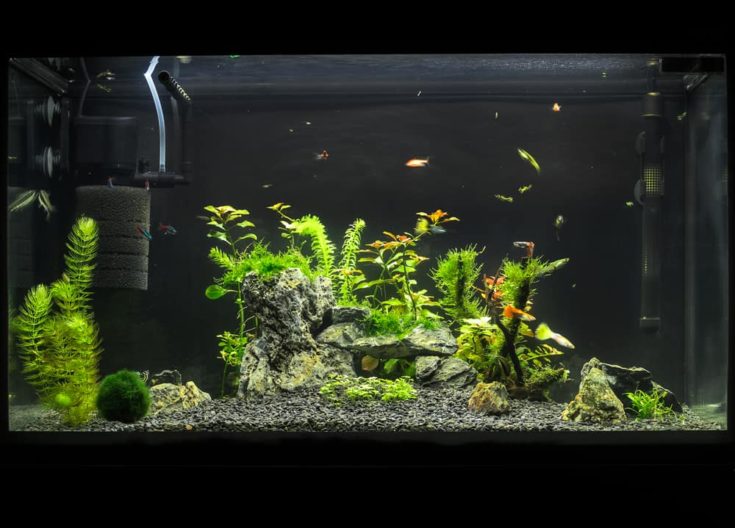
Start by gathering everything you need to set up your tank:
- Substrate
- Lighting unit
- Filtration system
- Heater
- Aquarium thermometer
- Caves, driftwood, etc.
- Plants
How to set up your aquarium:
1. Gravel and sand are usually dirty and dusty, so start by rinsing your substrate under running water. When the water runs clear, add the substrate to the aquarium to a depth of two to three inches.
2. Install the heater and filtration unit, but don’t switch them on.
3. Place an upturned saucer on the substrate. Fill your aquarium with untreated tap water, pouring it over the saucer so that the flow doesn’t dislodge the substrate. Don’t add dechlorinator to the water if you want to cycle the tank before introducing fish. The bacteria that you need in your biological filter media need the ammonia in untreated water to start the nitrogen cycle.
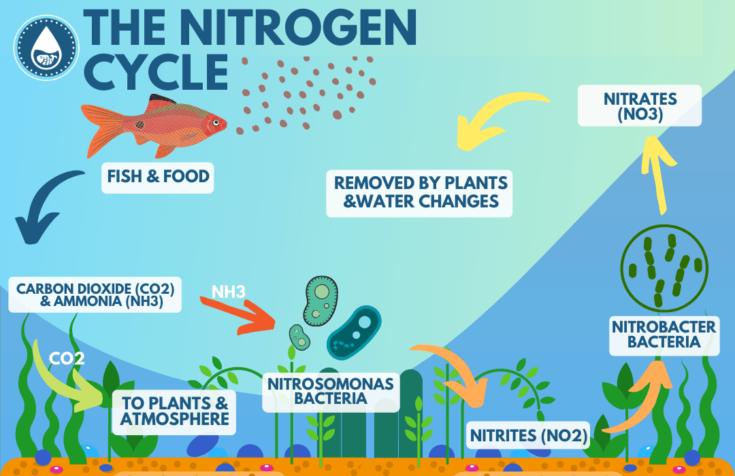
4. Add your decorations to the tank, rinsing them first to wash away any dust.
5. Now, you can add your plants. First, trim off any dead leaves or broken stems, and plant the specimens as per the supplier’s instructions, ideally in pots to prevent the Acaras from uprooting the plants.
6. Switch on the heater and the filter system, and leave the tank to cycle for at least ten days before introducing any livestock. Before you add any fish to the tank, use an aquarium water testing kit to ensure that the water is completely free from ammonia and nitrites. Nitrates should be below 20 parts per million (ppm) without harming your fish.
Habitat Requirements
Filtration
Electric Blue Acaras are quite large fish that generally inhabit bodies of water where the flow is relatively strong. So, you’ll need a canister filter or extra powerheads to help produce a powerful enough circulation.
Water Parameters
Water Temperature
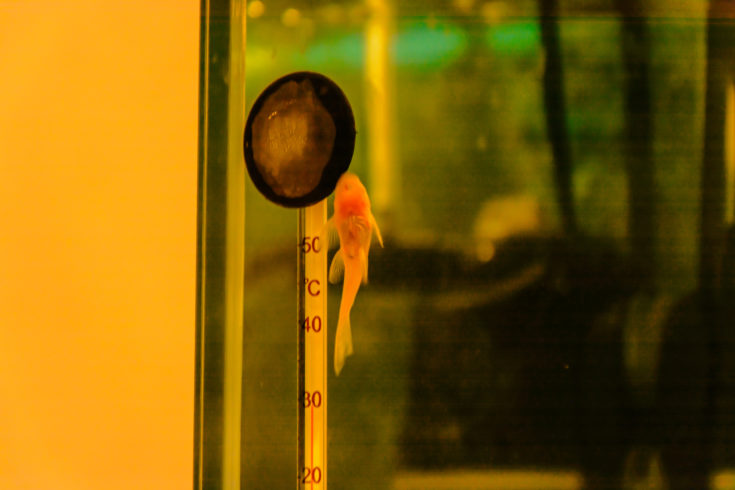
The water temperature in the tank should be kept at a constant 72° to 85° Fahrenheit, with 75° to 76° Fahrenheit being optimal.
Water Hardness And pH Range
The water hardness should be between 6 and 20 dGH, and the pH range should be 6.0 to 7.5.
Lighting
These fish prefer medium lighting levels, and you can use floating plants to diffuse the light if necessary.
Tank Maintenance
For your fish to remain healthy and happy, you’ll need to maintain the tank and keep it clean. So, every week you must carry out partial water changes to remove excess ammonia and nitrites and to keep nitrate levels down. Use an aquarium gravel vacuum cleaner to remove fish waste, uneaten food, and plant debris from the substrate.
Also, you’ll need to rinse the filter media in tank water to remove any sludge and replace the cartridges when necessary. Live plants will need trimming to prevent overgrowth and remove dead leaves and damaged stems.
Health And Disease
Signs Of Good Health
Electric Blue Acaras are active fish that spend much of their time digging in the substrate, exploring their surroundings, and rummaging through plants and underneath decorations.
These fish swim in all areas of the tank but mostly tend to hang out in the lower to mid regions.
Red Flags
Red flags to watch out for include lethargy, loss of appetite, and general disinterest in their surroundings. Although the Blue Acara does occasionally visit the surface of the aquarium, fish that are hanging from the surface are generally sick.
Also, lumps, red patches, swellings, torn fins, and flicking the body against tank decorations and the substrate are all signs of trouble.
Common Health Issues And Treatment
Health Issue
Ich (White Spot Disease)
Symptoms or Causes
Ich is a common disease that’s caused by the protozoan parasite, Ichthyophthirius multifiliis. Sick fish flick against solid surfaces, breathe rapidly, develop a rash of white spots on gills, body, and fins.
Suggested Action
Ich parasite lives in tank water, so quarantining individuals is ineffective. Treat the whole tank, raising the temperature to 82o F for three days, and use an over-the-counter, condition-specific remedy.
Health Issue
Skin and gill flukes
Symptoms or Causes
Skin and gill flukes are tiny parasites that embed themselves into the fish’s body or gills. Affected fish have red skin or gills, excess mucus on the skin, flicking or rubbing on substrate and tank décor, labored respiration.
Suggested Action
Correct tank water parameters, relieve overcrowding, treat with an over-the-counter drug as directed.
Health Issue
Fungal infections
Symptoms or Causes
White cotton-like growths.
Suggested Action
Quarantine affected fish; treat water with an antifungal remedy.
Health Issue
Bacterial infections
Symptoms or Causes
Skin ulcers, reddening of skin, cloudy eyes.
Suggested Action
Quarantine affected individuals; dose water with an over-the-counter antibacterial treatment.
Health Issue
Malawi bloat
Symptoms or Causes
Malawi bloat is a common disease of cichlids. Caused by poor diet, unsanitary tank conditions, and Clostridium difficile bacteria. Fish’s body swells up, loss of appetite, stringy, discolored feces, rapid breathing, lesions and ulcers appear on the body.
Suggested Action
Quarantine all affected fish and treat using antibiotics, such as Octozin or Metronidazole.
Breeding
Electric Blue Acaras are monogamous and are moderately easy to breed in the home tank. These fish are egg layers, depositing their eggs on flat surfaces that are open to the water, such as flat rocks on the substrate.
The fish are sexually mature once they grow to around two to three inches in length, although most begin breeding at four inches. Pairs of Acaras that are kept in optimum conditions may spawn several times every year.
As it gets close to spawning time, the male and female fish will display to each other more and more frequently until they are ready to spawn, and their color will increase in intensity.
Spawning Tank
The breeding tank should be at least 20 gallons. The water should be in the neutral to the mildly acidic range with a pH of 6.5 to 7.0 and with a soft to medium-hardness of between 3 and 12 dGH. The water temperature needs to be between 73o and 79o Fahrenheit. For perfect breeding.
Use a sandy substrate to cover the bottom of the tank, and place plenty of flat rocks on top that the female will use as a place to lay her eggs.
The female lays 150 to 200 eggs on a rock, and both parents care for and guard the eggs and fry. The eggs will incubate for two to three days when the fry will hatch and begin hunting for food. Although the fry is guarded by the male or female fish, during the first two weeks of their lives, the youngsters will stay close to their mother.
Availability
You can find Electric Blue Acaras at some good local fish stores, depending on where you live. These fish are also widely available through online dealers, and you’ll expect to pay between $6 and $15 for a specimen, depending on its age and size.
Product Recommendations
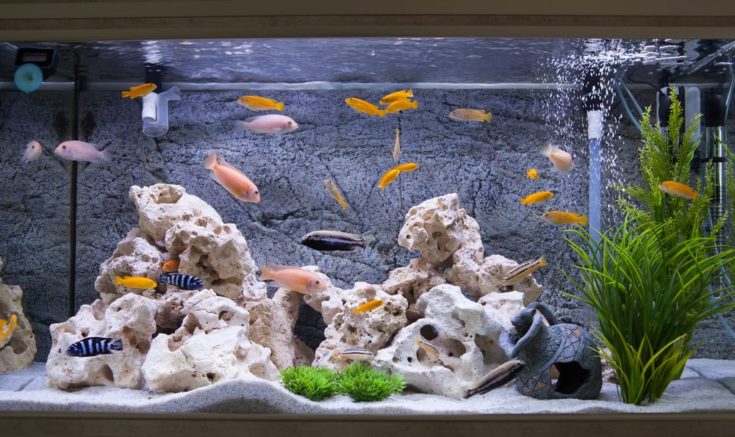
- Rectangular fish tank (minimum size 30 gallons)
- Filtration system
- Heater
- Water conditioner
- Lighting unit
- High-quality tropical flake food
- Selection of frozen foods
- Sandy substrate
- Rocks, driftwood, dried leaves
- Books on fishkeeping
- A fishnet
- Aquarium thermometer
- Aquarium vacuum or siphon cleaner
- Algae magnet
In Conclusion
I hope you enjoyed our Electric Blue Acara care guide and found it helpful. We’d love to know what you think, so please tell us in the comments box below. And, remember to share the article with your fishkeeping friends if you loved it!
